
© Rosalie O’Connor. (Click image for larger version)
Boston Ballet
Pricked: Etudes D.M.J. 1953-1977, Cacti
Boston, Opera House
8 May 2014
www.bostonballet.org
Boston Ballet’s latest production (oddly titled Pricked, leading you to expect a kinky Sleeping Beauty) opened May 8 at the Boston Opera House and featured three ballets spanning 62 years: Harold Lander’s Etudes (1948), Petr Zuska’s D.M.J. 1953-1977 (2004), and Alexander Ekman’s Cacti (2010).

© Rosalie O’Connor. (Click image for larger version)
I’d never seen Etudes by the Danish choreographer Harold Lander, though it’s been hugely popular ever since it premiered in Copenhagen in 1948. Set to the piano exercises of Carl Czerny (adapted and orchestrated by Knudage Riisager), it’s one of many ballets inspired by the idea of a ballet class. We begin with four quartets of women performing classical steps, their legs spotlighted with torsos and heads in darkness. Next the women are silhouetted against a light blue background, now performing more advanced movements with their entire bodies. Three soloists appear, a woman and two men, soon joined by a third man, and the woman performs a lovely and quintessentially Danish solo: buoyant movements, restrained elegance, delicate lyricism. (The style was established in the early 19th century by the great Danish choreographer August Bournonville and has been cherished and preserved in Denmark ever since.) The woman’s partners allow for increasingly elaborate combinations, fleshed out by a growing corps of men and women who eventually total 42.

© Rosalie O’Connor. (Click image for larger version)
Since dance classes involve enormous repetition, the danger inherent in a ballet based on a dance class is one of boredom. And indeed, I thought Lander’s conceit was wearing thin near the end when one of the males ran onto the stage and exploded in dazzling leaps and flourishing hands, creating an intensity I’ve rarely seen. On opening night that dancer was the spectacular Jeffrey Cirio who performed like a possessed genie let out of a bottle, every movement precise and full of authority. Then it was all fireworks from Cirio’s solo onward. Lines of men and women leapt across the stage in fast diagonals, larger groups appeared led by our four leads, and the piece built to a thrilling grand finale. It was easy to see why Etudes has been a favorite for over half a century.
The female lead on opening night was the ravishing Misa Kuranaga. At my third performance a splendid Ashley Ellis danced the same role. Ellis has always danced beautifully but to little effect since she seemed unable to project feeling. But she was superb at the Saturday matinee and fully connected to the audience. At that same performance Avetik Karapetyan was also first-rate, with a smile that lit the entire theater and enough energy and charisma for an entire corps.
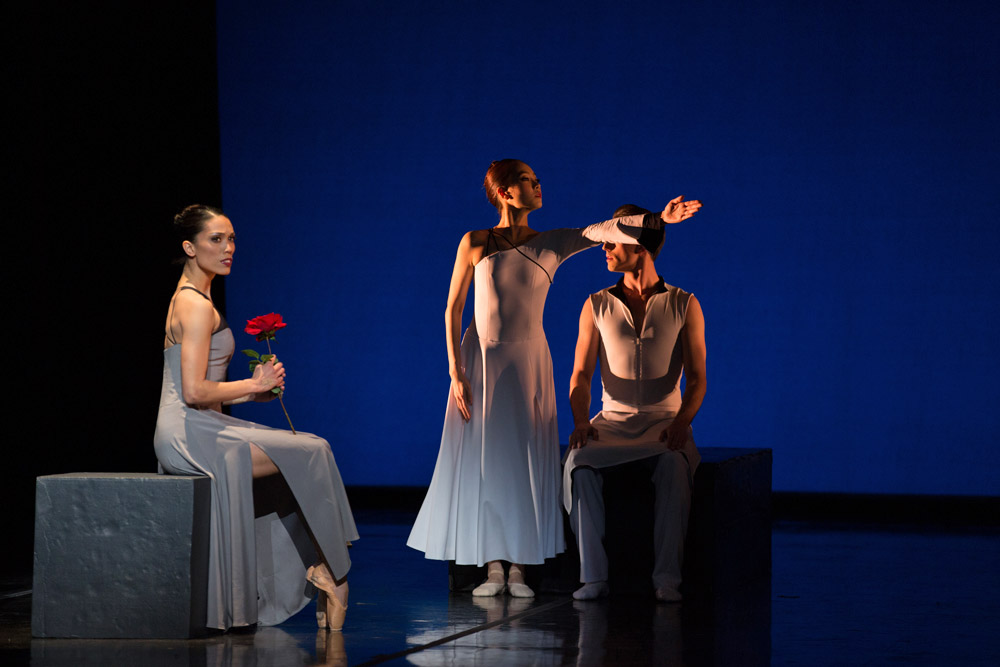
© Rosalie O’Connor. (Click image for larger version)
Petr Zuska’s D.M.J. 1953-1977 begins with a man in front of a black curtain laying a huge red rose on a large cube, perhaps paying homage to the three Czech composers alluded to in the title (D.M.J.=Dvorak, Martinu, Janacek). Or perhaps in remembrance of a failed love. Or perhaps… To the Largo of Dvorak’s New World Symphony the curtain rises and we see six women standing on rectangular megaliths, their male partners seated below. It’s immediately clear that the subject of the piece is human alienation: the women stand, the men sit; the women face one way, the men another; the women gesture right; the men, left. People are always separating, always at odds. Six red roses, one for each couple, rise out of sight, love and desire vanishing before our eyes. The man’s female partner appears and a balletic agon begins which continues through to the end.

© Rosalie O’Connor. (Click image for larger version)
Much of the choreography is original, with novel and beautiful lifts and turns, but although the piece displays intelligence and talent, it verges on pretension. The rose as a symbol of love is trite, and although only ten years old, the ballet felt dated, its emotion mired in mid-20th century existentialist angst. When the megaliths were strewn over the stage like a mini-Stonehenge, the set and choreography became reminiscent of Martha Graham. In an interview Zuska has said that the male lead might be the woman’s lover, or perhaps her alter ego, or maybe Death. When so much is offered, one rarely gets much of anything.
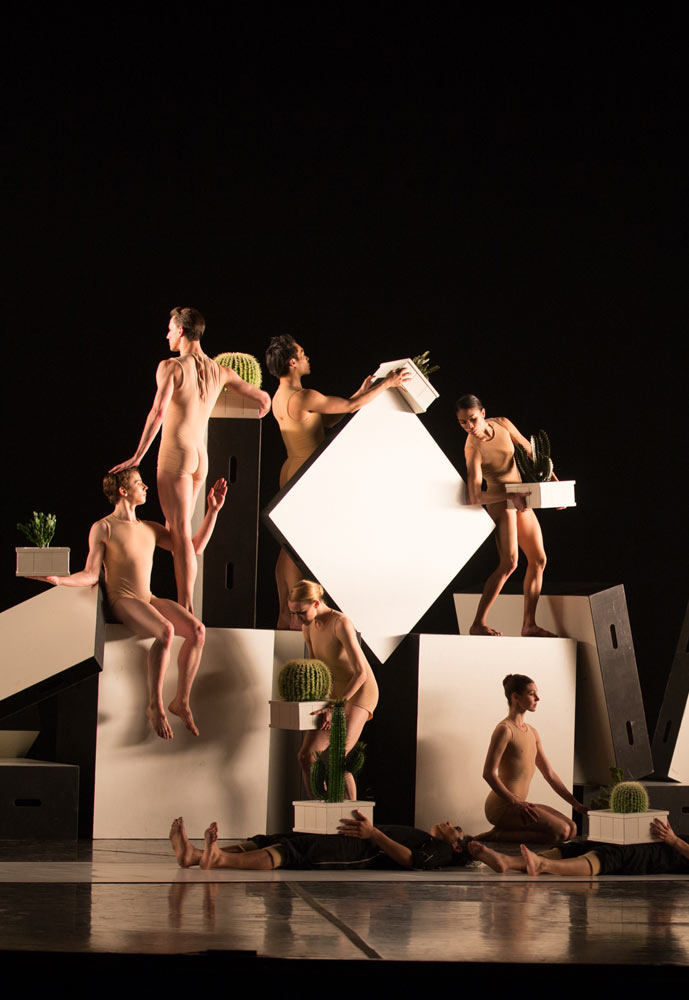
© Rosalie O’Connor. (Click image for larger version)
The evening ended with Alexander Ekman’s Cacti, one of the most wildly original, hilarious dances I’ve ever seen. If the Keystone Cops had taken up ballet, this is what they’d have looked like. At the beginning a string is repeatedly plucked by a spot-lit cellist as a voiceover intones platitudes about society and artistic creation: “Michelangelo’s metamorphoses… society… members of the human orchestra…” Twenty-four dancers dressed in loose beige tops, black pedal-pushers, and black skullcaps are kneeling on low platforms as a string quartet in evening dress wanders among them.

© Rosalie O’Connor. (Click image for larger version)
I’ve never seen such a variety of bodily movement in over 60 years of attending ballet. In the beginning the 16 dancers look like troglodytes gardening, then frenzied bakers pounding out dough as they beat their platforms in time to the string quartet’s music which they then begin conducting. Seated, they bounce in place, then standing, they shake their knees and fannies, jog in unison, scoop the air in huge arcs, and shimmy while gazing skyward. A woman flat on her back volleys a man’s head back and forth between her hands and the concave curve above her ankle. Then they all place cacti on their platforms, pointing to them and beaming proudly. Near the end, a man and woman begin to perform to their own hilarious voiceovers (Whitney Jensen and Jeffrey Cirio opening night, both fabulous). They’re trying to figure out how to end their failed relationship, and at one point the man says “What about our cat?” A dead cat falls plop onto the stage. “Well, I guess that says it all.”
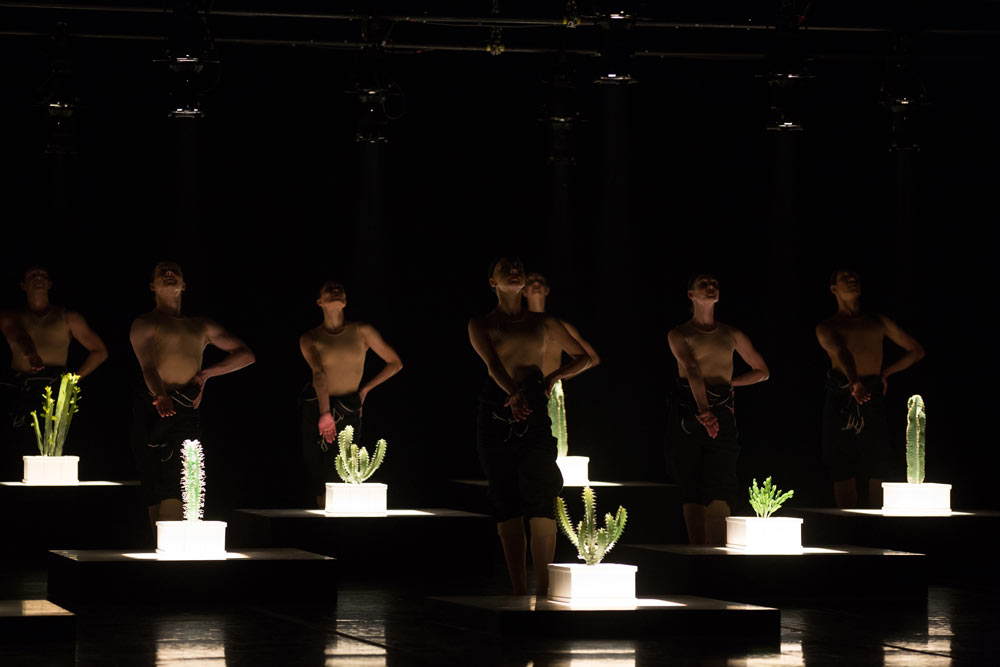
© Rosalie O’Connor. (Click image for larger version)
And I would guess that Cacti will wear well over time, but until we know, and if Fate is kind, Ekman will have many more opportunities to surprise and thrill us as much he does in this zany comic masterpiece.











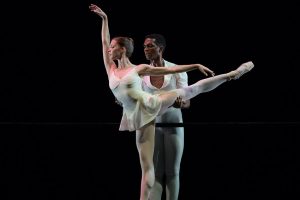

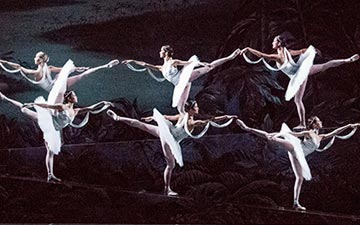



You must be logged in to post a comment.